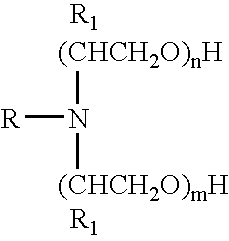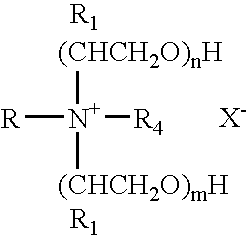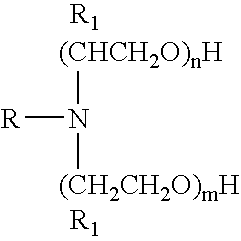Microemulsions containing alkoxylated amine carboxylates
a technology of alkoxylated amine carboxylate and microemulsion, which is applied in the direction of detergent compounding agent, hair cosmetics, inorganic non-surface active detergent composition, etc., can solve the problems of limiting the application of detergents, adding distinctive and often objectionable odors, adding voc's and objectionable odors, etc., to reduce or eliminate the formation of gelled, prevent the formation of insoluble precipitates, and high efficiency
- Summary
- Abstract
- Description
- Claims
- Application Information
AI Technical Summary
Benefits of technology
Problems solved by technology
Method used
Image
Examples
example 1
[0055]The organic salts or complexes described in Table 1 were formed by mixing the amines and acids described in equimolar quantities. Microemulsions were formed by mixing 3 g of the organic salts with 2 g of d'limonene, and adding water in increments and noting the appearance, until the mixture became cloudy indicating phase separation. The appearance when the compositions contained 25 percent by weight and 75 percent by weight water are noted in Table 1. When the surfactant is formed from propionic, benzoic, lauric, myristic and oleic acids, which are not compositions of this invention, the isotropic microemulsions of this invention do not form.
[0056]
TABLE 1AmineAcid25% water75% waterIsodecyl oxypropyl amine + 52-ethyl hexanoicisotropic2 phasesEOmicroemulsionCocoamine + 5 EOisopentanoicisotropic2 phasesmicroemulsionCocoamine + 5 EO2-ethylhexanoicisotropicisotropicmicroemulsionmicroemulsionCocoamine + 5 EOisononanoicisotropicisotropicmicroemulsionmicroemulsionCocoamine + 5 EOpelar...
example 2
[0057]An isotropic microemulsion with d'limonene as the oil phase was prepared from an equimolar mixture of an ethoxylated quaternary ammonium salt and sodium isononanoate, with the composition:
[0058]
Decyloxypropyl-bis(2-hydroxyethyl)methyl ammonium chloride15.8%Sodium isononanoate8.1%D′limonene14.4%Waterq.s
example 3
[0059]Cocoamine condensed with 5 moles of ethylene oxide and isononanoic acid were mixed in the molar ratios indicated in Table 2 and these mixtures were then mixed with d'limonene at the weight ratios indicated. Water was added in increments and appearance when the compositions contained 25 percent by weight and 75 percent by weight water was noted and is described in Table 2. The results show that microemulsions of this invention can be formed at molar ratios of amine to acid from about 0.5 to 2, and ratios between 1 and 1.25 are particularly efficacious.
[0060]
TABLE 2Molar ratio ofWt. ratio ofCocoamine + 5 EO tosurfactant toAppearanceIsononanoic acidd′limonene25% water75% water0.54:1isotropic2 phasesmicroemulsion0.753:2isotropic2 phasesmicroemulsion1.03:2isotropicisotropicmicroemulsionmicroemulsion1.02:3isotropicisotropicmicroemulsionmicroemulsion1.12:3isotropicisotropicmicroemulsionmicroemulsion1.11.75:3.25isotropicisotropicmicroemulsionmicroemulsion1.11.5:3.5isotropic2 phasesmic...
PUM
| Property | Measurement | Unit |
|---|---|---|
| weight ratio | aaaaa | aaaaa |
| weight ratio | aaaaa | aaaaa |
| boiling points | aaaaa | aaaaa |
Abstract
Description
Claims
Application Information
 Login to View More
Login to View More - R&D
- Intellectual Property
- Life Sciences
- Materials
- Tech Scout
- Unparalleled Data Quality
- Higher Quality Content
- 60% Fewer Hallucinations
Browse by: Latest US Patents, China's latest patents, Technical Efficacy Thesaurus, Application Domain, Technology Topic, Popular Technical Reports.
© 2025 PatSnap. All rights reserved.Legal|Privacy policy|Modern Slavery Act Transparency Statement|Sitemap|About US| Contact US: help@patsnap.com



